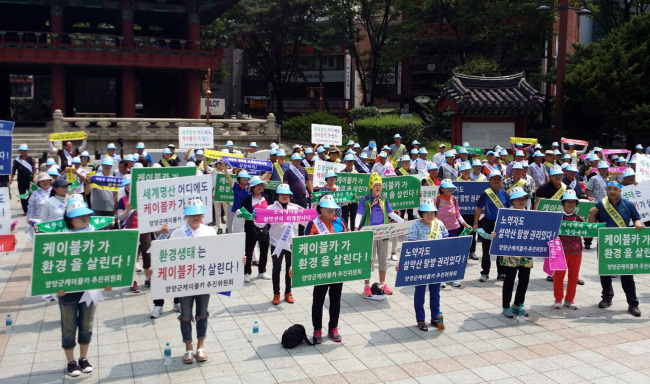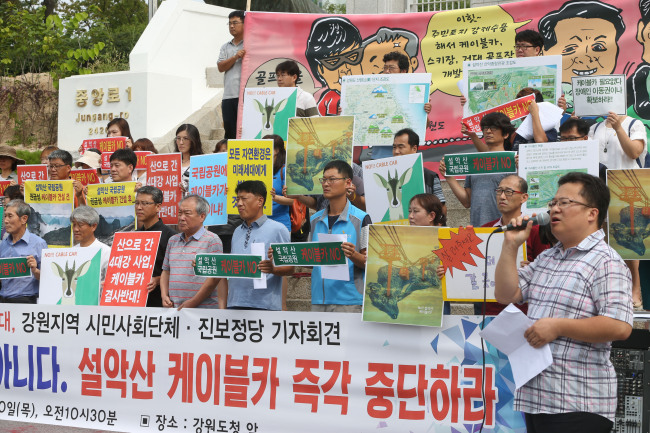Controversy is escalating over environmental impacts and the economic feasibility of a cable car that the local government is pushing to construct at one of the country’s most scenic and best-preserved national parks.
In April, Yangyang County Office in Gangwon Province applied to the Environment Ministry for a permit to construct a cable car at Mount Seoraksan, the province’s most popular tourist attraction.
Under the scheme, the city will build a 3.5-kilometer-long cable car to Geutcheong peak. The project aims at boosting the local economy and improving service for visitors, officials said.
“The new cable car will vitalize the local economy and offer more diverse travel routes for mountain visitors, especially for those who have difficulties in accessing the mountain such as the elderly or disabled,” said Yangyang County officials.
Six props and two stations will be built, which will cost around 46 billion won ($39 million) by 2017, they said.
 |
Yangyang residents urge the government to allow the cable car project at a demonstration in central Seoul on Aug. 13. Yonhap |
Hundreds of Yangyang residents have also endorsed the project, saying that the development of a new tourism source is necessary for their local businesses.
“It will not only stimulate the local economy, but also reduce the damage of original tourist routes, as the cable car will help disperse the number of visitors. It will also improve the ‘touring welfare’ for those who have difficulties accessing the mountain,” Yangyang residents said during their rally calling for the project permit last month. “The national park should be enjoyed not only by certain groups, but by everyone.”
Environmentalists, however, strongly opposed the plan, citing potential environmental impacts.
“The target area of the cable car is a habitat of various kinds of endangered animals, especially the mountain goats. Once the cable car route is built, the habitat will become more exposed to a large number of visitors, which will naturally damage the home of these precious species,” civic activist Lee Jang-kyo at Green Korea United told The Korea Herald. The mountain goat-like goral species is designated as a grade I endangered species by the government.
This is the county’s third application for the cable car.
In previous requests in 2012 and 2013, the Environment Ministry rejected both applications, citing concerns over the short distance between the Geutcheong station and mountain’s major peak Daecheongbong, and concerns over the habitat of the mountain goats.
Under the qualification criteria, the cable car stations must avoid natural habitats of the animals.
The location of the cable car’s destination must also be distant from the mountain’s major peak in order to minimize access of cable car users to preserved areas away from the usual hiking courses. The mountain’s major peak is designated by the government.
After the two previous plans were rejected, the Gangwon Provincial Government and Yangyang County Office changed the cable car route, and said the new location is far enough from animal habitat areas.
It increased the distance between the proposed mountaintop and Daecheongbong to 1.4 kilometers from 230 meters.
The county also vowed to restrict visitors from wandering away from the usual hiking routes around the cable car’s station to prevent damage.
Despite such modifications of the plan, civic groups still argue that the proposed route will inevitably harm the habitats for endangered animals.
 |
Activists hold a rally against the construction plan of a cable car on Mount Seoraksan in front of the Chuncheon City office in Gangwon Province on Aug. 20. Yonhap |
“More than 10 endangered species of animals live in the proposed route, including the mountain goat,” Lee of Green Korea United said.
Green Korea United has monitored the area with nine unmanned cameras for seven months and discovered a number of baby mountain goats in the proposed route area. They said the finding indicated a high possibility of the area being their actual habitat.
The Environment Ministry and Yangyang County also conducted a joint on-site inspection, but came to the opposite conclusion that the concerned region is not the habitat. They also added that the real habitat of the mountain goats is located over the mountain ridge.
Yangyang County also disagreed with concerns of civic groups regarding the construction of the cable car damaging the ecosystem.
“In the past, constructions of cable cars indeed tended to damage the environment as roads had to be built first to kick off the construction,” Yangyang official Kim Cheol-lae, who is in charge of the project, told The Korea Herald.
“This time, however, the construction will have little impact as the props will be fully assembled on the ground and delivered by helicopters to be planted at six spots.”
Experts, meanwhile, gave mixed views.
“The government must be aware of the characteristics of the endangered animals first. The mountain goat is usually cowardly. Whenever it hears the sound of humans, it runs away and hides over the rocky mountain. Once the cable car is constructed, the sound of the vehicle and visitors will ultimately affect its living,” said forest science professor Youn Yeo-chang at Seoul National University.
Choung Heung-lak, the head of Migang Ecology Institute, which conducts various environmental impact evaluations, offered a different opinion.
“The mountain goat is only sensitive to the sound of humans, not that of the artificial facilities. Once the cable car route is installed, the visitors’ access around the route area will likely be restricted for safety, therefore, the goats will be less exposed to visitors in the region. This will actually support their living.”
Opponents also point to the cultural value of Mount Seoraksan.
The 1708-meter-high mountain range, which is the third highest in the country, was designated as a national park in 1970 and a biosphere reserve by UNESCO as it has five sectioned preservation regions. It was also designated as a national monument in 1965.
The beautiful scenery attracts 3.4 million visitors every year, with about 700,000 reaching the top.
“Considering the mountain’s cultural value, the public must acknowledge that it is an asset that our generation should hand down to future generations. Launching a business project is equivalent to selling a precious asset of the next generation,” Youn added.
The governments, for their part, have underscored the economic benefits the cable cars would bring, although their data backing the argument have also been questioned by the civic groups.
According to the Korean Environment Institute, the ratio of economic benefits to cost was projected to be 1.214, with a result over 1.00 indicating that it is economically more feasible. The think tank also anticipated that the cable car operation would bring more than 150 billion won and nearly 1,000 new jobs.
Rep. Woo Won-shik of the New Politics Alliance for Democracy, however, claimed that the report did not sufficiently analyze the environmental factors of the project and that it was as a financial analysis report based on inaccurate data, such as an exaggerated number of expected passengers.
Yangyang City admitted to the wrong figures, but claimed that it was just a mistake. It later modified the data.
The final decision for the cable car project will be made Friday as the Environment Ministry holds a national park meeting, and the opponents fear that this time, the plan might get the green light.
In August last year, President Park Geun-hye vowed to actively support the cable car project of Mount Seoraksan as part of the government’s efforts to boost the local economy.
“I hope the cable car is pushed as early as possible, by the time the PyeongChang Winter Olympics are held (in 2018),” Park said.
Jang Kyu-seok, one of activists for the anti-cable car group in Yangyang County, said, “Despite the two rejections in the past, the city has hastily carried forward the cable car plan again all of a sudden after the president made a remark last year.”
Once allowed, the cable car would begin running in February 2018.
By Lee Hyun-jeong (
rene@heraldcorp.com)









![[Today’s K-pop] Blackpink’s Jennie, Lisa invited to Coachella as solo acts](http://res.heraldm.com/phpwas/restmb_idxmake.php?idx=644&simg=/content/image/2024/11/21/20241121050099_0.jpg)